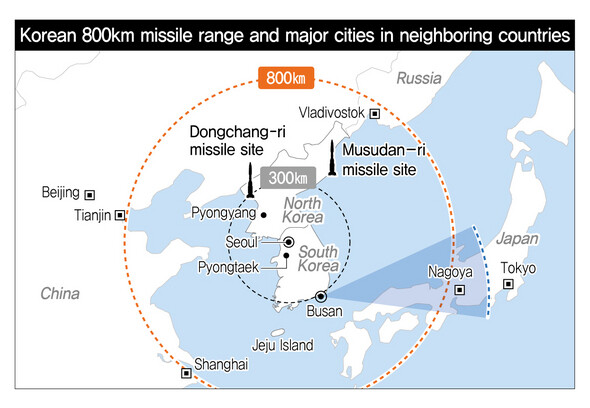hankyoreh
Links to other country sites 다른 나라 사이트 링크
[Editorial] Losses far outweigh gains in missile renegotiation

Missile negotiations between South Korea and the US concluded on Oct. 7 with a new agreement to extend the range of South Korea’s ballistic missiles from 300 kilometers to 800 kilometers. This will mean that all of North Korea will be within range.
The 500kg weight restriction on the missiles was maintained.
In accordance with a tradeoff provision, if missile range is increased, the warhead size must be decreased, so a missile with a 550 km strike radius can carry a 1,000 kg payload. This effectively means that the payload limit has been eliminated. The payload for unmanned aerial vehicles was also upped from 500 kg to the current international maximum of 2,500 kg.
North Korea has demonstrated new interest in further tipping the balance of arms on the peninsula with more nuclear weapons and upgraded missile technology, and the negotiations aimed at keeping their programs in check are stalled. The South therefore has no choice but to beef up its own military might while also pursuing dialogue with Pyongyang. Aside from simply discussing rights to possess certain missiles, it is only natural for South Korea to seek a deterrent for the worst contingencies. If only looked at from the issue of the missile agreement, it seems clear that South Korea has improved its own war deterrence.
The context of the negotiations, however, is quite worrisome. It is impossible to overlook the possibility that South Korea achieved this extension in range as a condition of participation in the missile defense program that the US is spearheading. If that is the case, it is clear that South Korea’s gains were far outweighed by the losses. Explaining the outcome of the talks, the South Korean Defense Ministry said that based on the new guidelines for missile development, South Korea will establish a chain response system, which, through immediate detection, identification, decision-making and attack will enable the country to deploy its missile power within moments.
Additionally, the ministry vowed to continue development on a Korean Air and Missile Defense (KAMD) shield capable of intercepting any threats before they can hit their targets. The Defense Ministry never came out and said that Korea would be joining the US-led missile defense program, but as good as admitted that missile negotiations and MD participation have now been lumped together.
Considering that it would put South Korea at the front lines of any missile hostilities between the US and China or Russia, and therefore impede the ultimate goal of peaceful reunification on the peninsula, one would be hard-pressed to find a more dangerous course of action. The government has explained that the KAMD is separate from the US-led missile defense system, but as it is impossible to construct a system that would detect a North Korean missile launch beforehand and be able to intercept it in the 6 to 7 minutes it would take to reach Seoul, the statements are far from convincing. It is also clear that participation in the MD will require immense public spending.
Making a decision of such magnitude in the final stretches of the current administration is foolhardy. Whether or not to participate in the MD is a decision that ought to be left to the next administration.
Please direct questions or comments to [english@hani.co.kr]

Editorial・opinion
![[Column] Park Geun-hye déjà vu in Yoon Suk-yeol [Column] Park Geun-hye déjà vu in Yoon Suk-yeol](https://flexible.img.hani.co.kr/flexible/normal/500/300/imgdb/original/2024/0424/651713945113788.jpg) [Column] Park Geun-hye déjà vu in Yoon Suk-yeol
[Column] Park Geun-hye déjà vu in Yoon Suk-yeol![[Editorial] New weight of N. Korea’s nuclear threats makes dialogue all the more urgent [Editorial] New weight of N. Korea’s nuclear threats makes dialogue all the more urgent](https://flexible.img.hani.co.kr/flexible/normal/500/300/imgdb/original/2024/0424/7317139454662664.jpg) [Editorial] New weight of N. Korea’s nuclear threats makes dialogue all the more urgent
[Editorial] New weight of N. Korea’s nuclear threats makes dialogue all the more urgent- [Guest essay] The real reason Korea’s new right wants to dub Rhee a founding father
- [Column] ‘Choson’: Is it time we start referring to N. Korea in its own terms?
- [Editorial] Japan’s rewriting of history with Korea has gone too far
- [Column] The president’s questionable capacity for dialogue
- [Column] Are chaebol firms just pizza pies for families to divvy up as they please?
- [Column] Has Korea, too, crossed the Rubicon on China?
- [Correspondent’s column] In Japan’s alliance with US, echoes of its past alliances with UK
- [Editorial] Does Yoon think the Korean public is wrong?
Most viewed articles
- 1‘We must say no’: Seoul defense chief on Korean, USFK involvement in hypothetical Taiwan crisis
- 2N. Korean delegation’s trip to Iran shows how Pyongyang is leveraging ties with Moscow
- 3‘Weddingflation’ breaks the bank for Korean couples-to-be
- 4[Reportage] On US campuses, student risk arrest as they call for divestment from Israel
- 5Amnesty notes ‘erosion’ of freedom of expression in Korea in annual human rights report
- 6[Column] Park Geun-hye déjà vu in Yoon Suk-yeol
- 7Korea sees more deaths than births for 52nd consecutive month in February
- 8[Editorial] New weight of N. Korea’s nuclear threats makes dialogue all the more urgent
- 9Will NewJeans end up collateral damage in internal feud at K-pop juggernaut Hybe?
- 10[Guest essay] The real reason Korea’s new right wants to dub Rhee a founding father